Trip Reports » Bike Packing in the Summer of 1966
This is a story about an adventure my brother John and I had over 52 years ago in 1966. We peddled our bicycles, unsupported, across the United States from Mountain View, California, to Spencer, New York, at the young ages of 15 and 17. It was, up until that time, the greatest and most difficult challenge I had ever set out to do. I can’t speak for John in this narrative but he and I have been in communication about this story. Just talking about those past memories of our journey together has brought up more and more visions, flashbacks and questions about that early bike packing adventure. I call it bike packing now, but in 1966 it would have been as foreign a concept as handheld computers. After re-creating our route on a Google Earth path line, the statistics are impressive: 2,971 total miles, 102,725 feet of vertical gain traveling 26 riding days for an average of 114 miles per day. Ah, the exuberance and ambition of youth!
We lived in the San Francisco Bay Area since 1958 when our parents moved us to California in that great migration that occurred from east to west during the fifties. In 1966, John and I were attending Awalt High School in Mountain View. Between paper routes and the practical aspects of getting around, my bicycle, for me, was literally a vehicle offering freedom and adventure for a young teenager who could not yet drive. Day rides on weekends into the foothills of the coast range and beyond were common. It wasn’t until a summer trip to upstate New York in 1964 that John and I started talking seriously about a cross country bicycle trip.
There were some obvious challenges that presented themselves, and as determined teenagers we proceeded to address each one head on. First, we needed better bicycles. Those old worn Schwinn two speed bikes we used to get around on were not going to work. We also needed a plan including a route, maps, supplies and gear. We were going to need money which we would have to earn to cover our living expenses, and a trip of this magnitude would require training with lots of “saddle time” in order to be in shape. If that wasn’t enough, the hardest challenge of all still faced us: getting permission from our parents to go. I think the first thing that clued our mom and dad that we were serious about this trip was when travel pamphlets and maps began to arrive from various states in our mailbox. The excitement the maps generated was contagious as we laid them out on our kitchen table, studying various routes, the roads, high mountain passes and towns along the way, the trip became real in my mind. If only we had had Google Earth back then!
John and I purchased our new Schwinn Continental 10 speed bikes together. After a little internet research I have discovered that we paid around $82.00 apiece for them; not a small sum of money in 1966. Each bike was equipped with an odometer that mounted down by the front hub while the distance was “clicked” off by a spoke mounted knob on every rotation. They would continually give us problems maintaining an accurate record of our mileage. A flat rack was mounted over the 27” rear wheel, while twin aluminum water containers graced the handlebars. Those bottles had a large cork cap which we were always afraid of loosing somewhere. Little did we know that we would need to carry at least twice as much water when crossing the great American west.
At my now “young” age of 67, I am still an avid cyclist, enjoying both road and mountain biking while living in Western Colorado. For all of my rides, I would feel naked heading out on any trip without my helmet. In 1966, bicycle helmets were not even considered. Maybe they were available, but I sure can’t remember ever seeing anyone wear one.The only head gear we wore was a soft wool cap which protected our head from the sun, and no sunglasses did we wear. I’ve done my share of bike packing over the years and we still do our annual supported group ride in the fall. We take great effort to ensure our comfort with good food and adequate provisions for the elements. When I look back at our meager camping set up with no tent, flannel sleeping bags, light cotton clothing and a limited water supply, I wonder at our incredible good luck with the weather and our naive attitude that everything will work out just fine. Apparently our personal comfort and safety were not overriding concerns. We must have thought we were invincible. What were my parents thinking?
In 1966 teenagers earned money in various ways. Seasonally, there were cherries, apricots and plums to be picked in the surrounding orchards. We also had supportive neighbors who paid us to wash and sometimes wax their cars. Folding daily newspapers for bicycle delivery was a common sight in our garage. With the money we saved, we budgeted $7.00 per day for food and incidentals – for the two of us. The actual amount was $7.70.
Our training rides became more challenging and longer as our departure date neared. Our parents owned a summer retreat at Lake Berryessa, a 140 mile journey to the north in Napa County. The ride to the lake was not an easy route and took most of a long day with sections of heavy traffic, back country roads and lots of hills. The Delta area was especially treacherous with a high, narrow and heavily trafficked bridge at Antioch and a long stretch of busy highway beyond Rio Vista, with no shoulder to speak of. I especially enjoyed riding those flat levy roads, however, and took the other hazards in stride. Our only overnight training ride was to visit family friends across the Central Valley in Oakdale, a small community at the edge of the foothills of the Sierra’s. This gave us the opportunity to ride back to back 100 mile days while climbing Altamont Pass (768’), east of Livermore, both days. In all, we probably logged more than 1,000 miles training before heading on our long ride.
My parents raised four sons, with John and I falling in the center between Jim, the eldest and Tom the youngest. John and I, being only two years apart, were the closest. Until he went off to college in Oregon, John and I were always together just “messing around” at things that boys do. It was no surprise that together we hatched this wild idea about a cross country bike ride to visit our grandparents near Ithaca, New York. I still have no recollection of my parents saying, “Yes boys, you have our permission to go on this potentially fraught with danger adventure.” There was a time when I realized that we had our parents blessing however, when Mom sewed up two canvas bags to match our sleeping bags for storage of all our personal items and clothing. These we would lash down with a chord next to our thin flannel sleeping bags over the rear wheel and a plastic tarp to cover it all. That was it. We knew we had our green light to go as soon as the school year was over in June.
Our parents did issue three stipulations however to gain their permission for the trip. First, we were to stay in a town each night, and second, we were to check in with the local police when we arrived. This turned out to be a smart move as we could be found within one days’ ride from the last police station we checked in with. The third, we were to call them every Tuesday and Saturday nights. Most of the time this arrangement worked just fine, with the police offering accommodations in the town park or even in their jail cells.
Luckily, John kept a journal of each days’ activities including our mileage, route and road conditions, towns which we passed through and any note worthy happenings of the day. This journal has been invaluable in order to accurately describe the route which we rode, the towns we stopped in each night and even our moods, both high and low, that would inevidably arise. After 52 years, the memory gets short.
Friday, June 17th – The Big Day Arrives
 There was a routine which developed right from the first day we left. Each morning we woke early and were usually on the road by 5:30 am. We left Mountain View the morning of June 17, the day after school let out for the summer. The entire family was there to see us off. We wouldn’t see them for over two weeks as they would all be driving out with a planned rendezvous near the Mississippi River just in case we were ready to call it quits. While I am not superstitious, the two flat tires I got before leaving the city limits of Mountain View did have me rattled. A joint decision was made NOT to go back but to deal with the situation at hand. Flat tires were to plague us often on this journey. In 1966, freeways were still primarily an urban experience while the Interstate Highway system was just being built along the rural highways. By then, we were accustomed to heavily trafficked roads with limited shoulders. The big truck rigs that cyclists experience today just didn’t exist. Most of the time, we could avoid the busier roads by altering our course to smaller back roads. Sometimes, it was just not possible.
There was a routine which developed right from the first day we left. Each morning we woke early and were usually on the road by 5:30 am. We left Mountain View the morning of June 17, the day after school let out for the summer. The entire family was there to see us off. We wouldn’t see them for over two weeks as they would all be driving out with a planned rendezvous near the Mississippi River just in case we were ready to call it quits. While I am not superstitious, the two flat tires I got before leaving the city limits of Mountain View did have me rattled. A joint decision was made NOT to go back but to deal with the situation at hand. Flat tires were to plague us often on this journey. In 1966, freeways were still primarily an urban experience while the Interstate Highway system was just being built along the rural highways. By then, we were accustomed to heavily trafficked roads with limited shoulders. The big truck rigs that cyclists experience today just didn’t exist. Most of the time, we could avoid the busier roads by altering our course to smaller back roads. Sometimes, it was just not possible.
Our first night was spent in Jackson, California, on Highway 88 in the western foothills of the Sierra Nevada mountains after riding 132 miles. It was the first of many small town parks where we bedded down for the night after a dinner at the local A&W . We would follow 88 over the Sierras via Carson Pass (8,652’) the next day, dropping off the steep eastern side of the mountains into Nevada. It was also our biggest climbing day of the entire trip with over 10,500 feet of vertical gain. Sleeping accommodations were mostly unplanned, such as our night in Carson City, Nevada, which was spent on the ground in a trailer court just east of the capital.
If you’ve never driven or ridden Highway 50 across Nevada – “The Loneliest Road in America”, – you’re missing out on one of America’s premier traveling adventures. Nevada has its own charm with miles and miles of basin and range, sage brush and grand vistas. In 1966 it was not so different as it is today, yet on a bicycle, those endless stretches of straight roads across the basins and the BIG climbs over the ranges, one after another took their toll on us. To this day, Highway 50 across Nevada and Utah remain one of my favorite drives. I hope to someday cross Nevada on my mountain bike on some of the many dirt roads that cross the basin and range. In 1966 sections of Highway 50 were being built over New Pass Summit west of Austin, so John and I rode the original highway through Eastgate, one of the original pony express way stations, and over steep and windy Carroll Summit. Having arrived in Austin early, we decided to head for what we thought was a small town on the east side of Austin and Scott Summits.
As it turned out however, not only did we not end up in town but we missed our first planned telephone call home due to an out of order phone. Needless to say, our parents were concerned. They notified the Nevada State police and since we were a whole day ahead of schedule, we were not where they though we should have been. Unknown to us, there was a police search underway looking for us around Lake Tahoe. The next day, we woke up to two flat tires after spending the night in the back of a pickup truck at an isolated motel east of Scott Summit. That day we accepted a ride with a trucker hauling, of all things, California potatoes to Idaho. In Eureka, Nevada, we were forced to get two “hot patches” placed on our tubes ( Total cost: “two bits”) and ride our bikes on to Ely – 85 miles away. I’ll never forget the “thump, thump thump” of the wheel with those tube distorting patches. After finally calling home, getting our tires repaired and getting a swim in at the city pool, we were feeling pretty good about our next day of riding. We were also spending our first night behind bars in the White Pine County jail.
The jailers in Ely woke us up early and got us on our way with hot chocolate and donuts. After arriving at the junction with Baker, close to the Utah border, we made a decision to go on to Delta, Utah, 95 miles away. Being young in 1966 had some advantages. People were very sympathetic to our mission and offered small bits of help along the entire trip. Water, sodas and snacks were freely offered and accepted. This day the help we received meant our very survival, as we were not packing nearly enough water for the desolate stretch between Baker and Delta. That was to be our longest day of riding both time and distance wise of the entire trip, a total of 155 miles with the last thirty miles fighting a head wind over very flat and desolate terrain. We splurged for a motel and a well deserved shower that night.
After leaving Delta the next morning (June 23rd), we again underestimated the remoteness and isolation of the small “towns” in the west. We should have been packing much more food and water than we were and this day caught us riding for hours on empty stomachs, over 50 miles between Delta and Eureka, Utah. After Eureka however, the highway drops towards Utah Lake and Provo. There we experienced the first urban traffic since the Bay Area. As we approached Provo, all we could see was a massive wall of mountains. Eventually, a narrow canyon became visible which the highway follows. The climb up through Provo Canyon towards Heber is a beautiful ride and that night found us again in a small two cell jail after a ride of 124 miles. Heber is a bit like Mayberry because when we woke the next morning, there was Otis, the town drunk, sleeping it off in the next cell.
The next day would bring us to the high point of our trip when we crossed over Bald Mountain Pass (10,674 ft.), dropping down into Evenston, Wyoming and connecting with Highway 30. There was still snow up on the pass in late June and we knew we were in for a chilly descent. After putting on every stitch of clothes we had, we were still cold as we coasted down the north side of the mountains, almost 30 miles of well deserved downhill riding. It was in Evenston, sleeping outside in the town park, where we realized how inadequate our sleeping bags were. The thin flannel bags just could not keep us warm, even with all our clothes on. Those nights in Wyoming were nights where our water bottles were freezing up.
When we planned our route, we made a decision to avoid the high passes of the Rocky Mountains of Colorado by staying north on the old Highway 30 and Interstate 80 in Wyoming which has no major passes. Interstate 80 was in various stages of completion our entire way across the state. We wound up riding through miles of construction but also on some newly completed freeway which we found extremely enjoyable to ride on since these were not yet open to traffic.
On June 26th, we passed over the Continental Divide before Sinclair. It was kind of anti-climatic as it’s just another hill with nothing so distinctive about it. Others before us had taken advantage of this fact as this was the major thoroughfare for the first transcontinental railroad and thousands of covered wagons heading west. Besides the cold nights, I remember the night in Sinclair, Wyoming being woken up by the park custodian informing us the sprinklers were about to come on and we needed to move. We wound up camped close (like 50 ft) to the Union Pacific main line. What a night! Trains were coming through at regular intervals and the ground would literally shake as it roared by. Why we didn’t get up and move I’ll never know.
By now our tires were showing the wear and tear of riding 100 plus miles each day. About 20 miles west of Laramie, my back tire blew out but luckily we were able to hitch a ride into town and purchase new back tires for both John and me – total bill was $11.70. We spent our last night in Wyoming at the high point between Laramie and Cheyenne called “Tree in the Rock” sandwiched between the east and west bound lanes of Interstate 80. I remember those picnic tables were mighty hard to sleep on. It was also our last cold night of the trip as we headed down onto the great plains, through Cheyenne and into Nebraska.
 Following the Platte River eastward on Highway 30 in Nebraska took three days and it was a rather boring ride due to a never ending flat landscape each day. It got warm early in the day and stayed warm into the night. The worst part though was the wind that came directly at us starting by 10 o’clock each morning. These were our most frustrating days of riding, having to drop into our lower gears on flat ground just to make progress against the headwind. The days were a blur of monotonous riding. Sidney to North Platte- 117 miles. North Platte to Kearney – 98 miles. Kearney to Osceola- 91 miles. The miles clicked on by through the flat farm lands of Nebraska as we headed towards Omaha. The country finally began to change for the better after Wahoo, Nebraska. It was more rolling with trees and visually more interesting. July 2nd saw us in Omaha, and crossing the Missouri River into Iowa , riding on to Glenwood, 113 miles that day. By now our scheduled rendezvous with the family was set for July 5th in Burlington, Iowa, on the Mississippi River. That allowed us to slow our pace a bit. July 3rd saw us in Creston, Iowa after riding 82 miles. Then Creston to Ottumwa, Iowa, – 111 miles where we spent another night in jail and finally on to Burlington, Iowa- 77 miles. We arrived by 11:30 in the morning in the rain, our first precipitation of the trip. The family would not arrive until later that evening, but I remember how great it felt NOT to hop on the bike and start pedaling the next morning. Our parents treated us to two nights in the Holiday Inn, relaxing around the swimming pool and eating better than we had for the past two weeks
Following the Platte River eastward on Highway 30 in Nebraska took three days and it was a rather boring ride due to a never ending flat landscape each day. It got warm early in the day and stayed warm into the night. The worst part though was the wind that came directly at us starting by 10 o’clock each morning. These were our most frustrating days of riding, having to drop into our lower gears on flat ground just to make progress against the headwind. The days were a blur of monotonous riding. Sidney to North Platte- 117 miles. North Platte to Kearney – 98 miles. Kearney to Osceola- 91 miles. The miles clicked on by through the flat farm lands of Nebraska as we headed towards Omaha. The country finally began to change for the better after Wahoo, Nebraska. It was more rolling with trees and visually more interesting. July 2nd saw us in Omaha, and crossing the Missouri River into Iowa , riding on to Glenwood, 113 miles that day. By now our scheduled rendezvous with the family was set for July 5th in Burlington, Iowa, on the Mississippi River. That allowed us to slow our pace a bit. July 3rd saw us in Creston, Iowa after riding 82 miles. Then Creston to Ottumwa, Iowa, – 111 miles where we spent another night in jail and finally on to Burlington, Iowa- 77 miles. We arrived by 11:30 in the morning in the rain, our first precipitation of the trip. The family would not arrive until later that evening, but I remember how great it felt NOT to hop on the bike and start pedaling the next morning. Our parents treated us to two nights in the Holiday Inn, relaxing around the swimming pool and eating better than we had for the past two weeks
You might be wondering just exactly what were we eating on this trip. The short answer is plenty of sweets and carbs. We had actually approached both A&W and McDonalds for sponsorships but both corporations declined. We would usually eat pastries and milk in the morning, sodas, sandwiches or burgers for lunch and chicken or pasta for dinner and a daily milkshake. We were not outfitted to do any cooking so we were dependent on restaurants, soda fountains and truck stops for our food. We would carry candy bars and other snacks for a quick bite to eat between meals. We both lost weight as might be expected. I lost 6 pounds and John lost 3 before finishing the trip. Both of us were mighty tired of that diet, and I now wonder why we didn’t expand our culinary horizon a bit more. I’ll just speculate and blame it on being high energy teenagers with limited funds.
It was in Burlington, Iowa that we had our first interview for a local radio station. While traveling through Nebraska, we had been interviewed for two local newspapers in Dawson County and Lexington. It was not to be our last before reaching our destination.
It was in also in Burlington where we both decided to continue on with our cycling adventure. The one day lay over did wonders for our morale and the one day reprieve was welcome. So on July 7th, after paying fifteen cents each to cross the Mississippi River, we continued our trip eastward, watching our family pass us in the station wagon early into Illinois.
We rode on to El Paso, Illinois, after a 120 mile day, sleeping in the town park. As teenagers, it was easy to make friends with other kids in the towns where we stayed. We must have been an unusual site to see for many of these small town kids. I remember a few times after stepping out of a restaurant or soda fountain, there would be people standing around our bicycles looking at our setup for long distant travel. Some had never even seen a ten speed bicycle before.
The next day we rode to the twin lakes town of Monticello, Indiana, 122 miles from El Paso. That was the day I left my wallet at a soda fountain in Gillman and didn’t discover the fact until six miles down the road. It was just then, that a lady drives up and asked if we had left a wallet. The lady drove back to retrieve it for us while we waited. People were very kind and generous to us. While camped along Lake Freeman that evening in Monticello, we met a teenager whose family owned a boat. He was happy to show us around the lake. We had one good spell of rain the next day between Monticello, Indiana, and Van Wert, Ohio, a distance of 123 miles. For rain gear we used parkas. That was it, and they didn’t work too well either, as might be expected. Luckily, the weather was warm and the rain squall came with a tail wind, pushing us into Van Wert at a 21 mph clip. There we showered at the YMCA and got our clothes into a laundromat to dry. We also found ourselves in the Van Wert city jail that night.
As I read through John’s account of our trip, I realize we were riding sometimes long days. My guess is that there was nothing better for us to do so why not get the extra miles in each day. The ride from Van Wert to West Salem, Ohio is 138 miles, our second longest day of the trip plus we set a milestone by riding in four states in three days since leaving Burlington. Our last days of the ride must have seen us with a “lets get there” attitude, as we got closer and closer to Spencer. John even made a note in the journal that we had altered our route to shorten the trip by a day, creating a surprise arrival to our grandparents house. There are a few things that stand out however. We made a brief detour in Akron, Ohio to see the Soap Box Derby Hill. For us kids in the 60’s, the Soap Box Derby was a big deal and the slight detour was well worth the time to see the famous downhill course. Also, shortly after we passed through the small town of Warren, Pennsylvania, I believe, a kid comes riding up to catch us letting us know there was some kid back in town that wanted to “fight”. Wow! We kindly declined and kept on riding. I remember the new dam being built at the time above Warren, as the road bypassing the dam and reservoir was brand new.
The second to last day in hilly Pennsylvania near Polk, John’s rear shifter cable broke leaving him in his two highest gears. Even in the larger town of Franklin, just up the road, a bike shop was not to be found and John was force to ride the rest of the trip with the broken cable. We finally pulled into our grandparents’ home near Spencer tired, suntanned and looking pretty lean.
The confidence that was developed in me cannot be over stated. At 15 years of age, I had a whole new perspective on the world and how my life could be.and it stands today as one of many highlights in my life. I hope this trip inspires others to tax their abilities and take a chance on their next big adventure.
Paul Koski
Nucla, Colorado
2018

 The Google earth path line of our route across the US.
The Google earth path line of our route across the US.
Leaving Molas Pass on a recent Durango to Moab Hut to Hut trip.
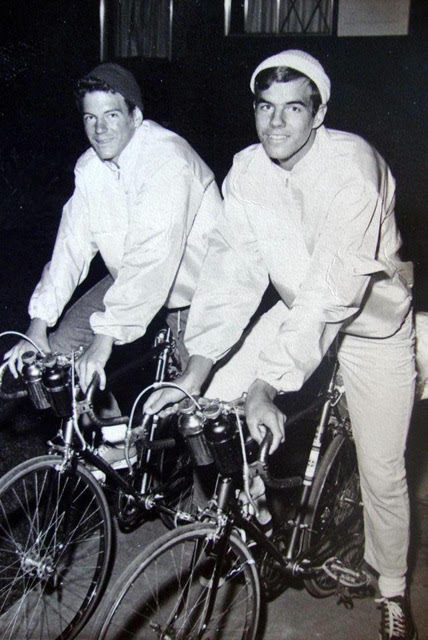
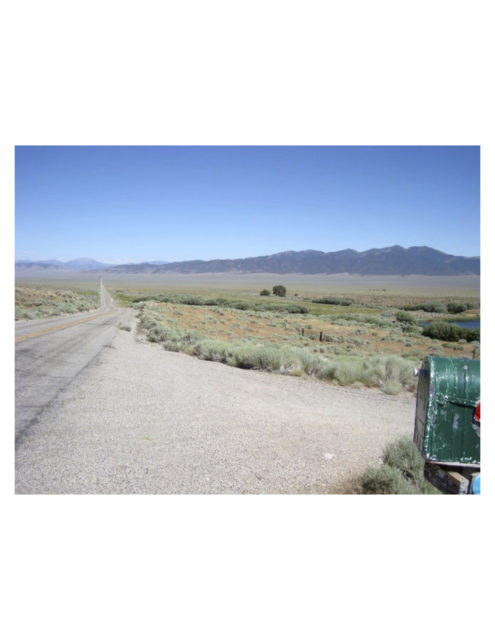
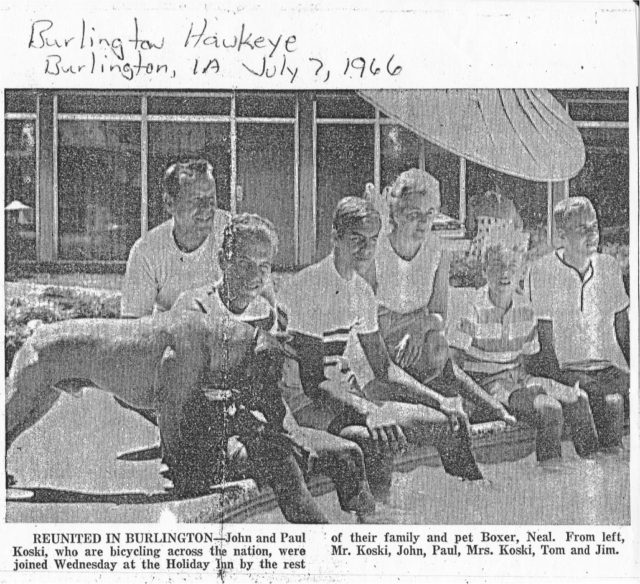
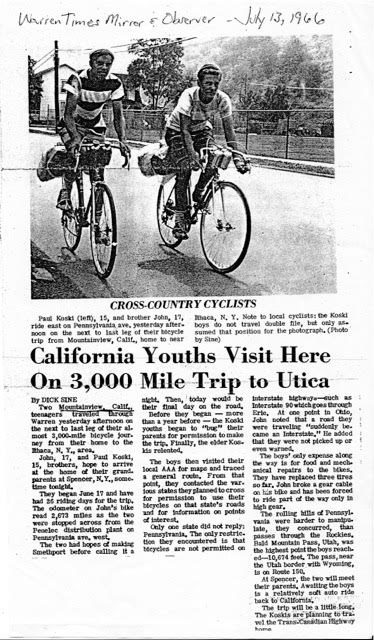

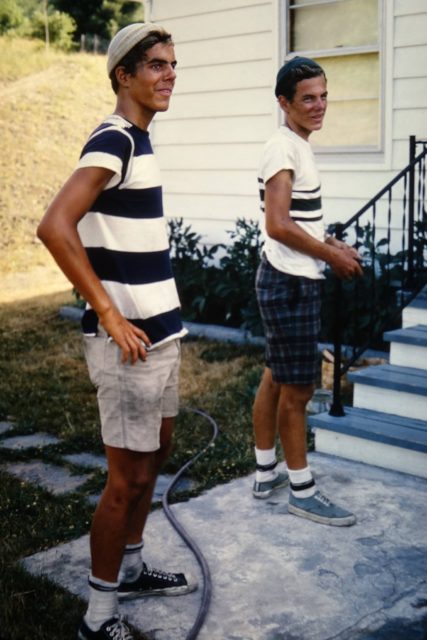



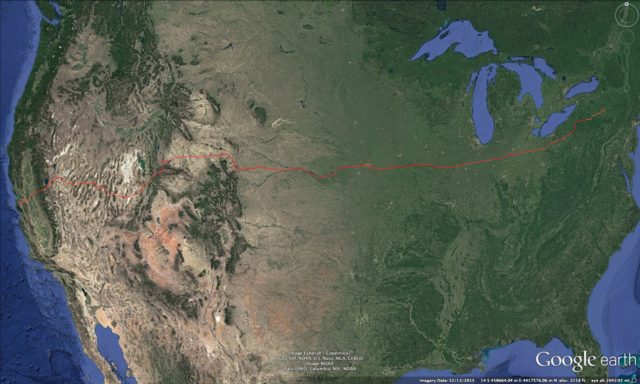
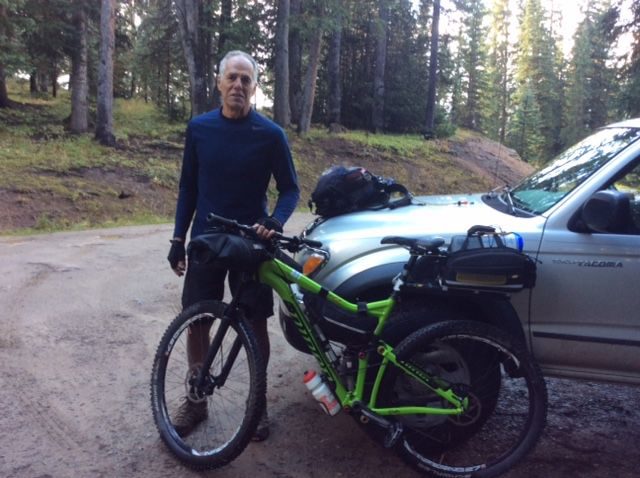
Incredible! Thanks so much for sharing your adventure.
Very big cinema, Paul! Enjoyed so much to read your story. It’s always the first of everything that we remember the most. Reminds me of my first bicycle tour along the Rhine valley, Germany, with three class mates, back in the 80s. I was 17. Material was not that important at that age. A Dutch style bicycle with a “Torpedo Dreigang” 3-speed hub from Sachs and tons of baggage in all-but-waterproof panniers were enough to start the adventure. Drops of black oil were dripping off my rear hub when the coaster brake ran hot on a long downhill.
Your adventure reminds me of The Endless Summer, filmed the same year. Two California boys on an adventure of a lifetime. Your statement of how this gave you confidence has to be an understatement. I think of myself at 15 and know I couldn’t have done such a thing. It also is a testament to your family and parents. You are so lucky to have had that experience.
Your adventure reminds me of The Endless Summer, filmed the same year. Two California boys on an adventure of a lifetime. Your statement of how this gave you confidence has to be an understatement. I think of myself at 15 and know I couldn’t have done such a thing. It also is a testament to your family and parents. You are so lucky to have had that experience.
I thoroughly enjoyed reading your story. How did this affect your brotherly relationship? Did you grow even closer? Did you have conflict along the way?
I love the photos! My favourite is the one of you coming up your grandparents’ driveway.
Thanks for sharing!
I LOVE this! An incredible story and life-shaping experience. And also helps put perspective on your deep involvement in the biking trail development down there on the Colorado Plateau. Thanks a ton for sharing this, Paul, and I hope you actually meet you in person one of these days.
a fantastic story of a bold adventure. I can totally relate to areas you biked, such as Hwy 50. I’ve driven that stretch maybe 30 times when commuting between Lake Tahoe and Sandy Utah, where I spent time mountain biking around Mt Wheeler and also up through Provo Canyon to Heber City where I lived for 2 years after moving there from Lake Tahoe. It’s truly a great story and one I hope will inspire more young and older people to get out there and explore the beauty of nature and the beauty within themselves too. more so, it’s warming to see you’re still out there doing it too. I take my helmet off to you, and your brother. At 66 years young, I’m bike packing Asia solo and am currently holed up in the Visayas, Philippines due to COVID-19..
The aerospace or space industry is quite delicate. If you are a manufacturer, you would know how important quality is. A single defect can cause you a fortune. People may even lose life at times. Therefore, a quality-based standard is necessary for the aircraft industry.
as9100 certification los angeles
Amazing story.. thank you for sharing!
Great story , really enjoyed reading it.
Wow! What an amazing adventure!! I love it. Thanks so much for sharing it.
Paul your story is wonderful, inspiring and no wonder it has set you up for a lifetime of cycling and adventure.
Brilliant!
What a great memory. Really enjoyed reading you story and realising how much has changed since 1966. Thanks for sharing